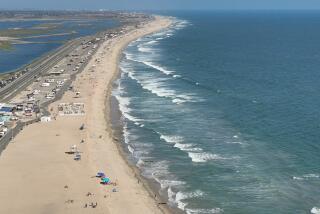ART REVIEW : ‘Paradise’ a Charming Detour at Laguna Beach
LAGUNA BEACH — Despite humankind’s follies, nature goes on making gray and sunny days to grow her vast garden. That’s probably why the Laguna Art Museum’s new show of 35 California Impressionist paintings is such a relaxing turn at this time of year when spring joins hands with summer. It was organized by curator Bolton Colburn and is called “Why Paradise: Permanent Collection Paintings From the Teens and Twenties.”
There was a time when the museum was embarrassed by its holding of local plein-air landscapes. Not modern or mainstream enough, just provincial stuff beloved by the matron patrons of the place. But a relentless urge to revive local art and history has brought work like this back to the light. It’s one of the few good fruits, where art is concerned, of a conservative turn in the culture.
They are a pleasure to encounter after taking Laguna Canyon Road off the freeway to the beachside repository. The lazy-hilled landscape surrounding this beachside repository still looks like Granville Redmond’s 1929 “Poppy Field Landscape,” and the real view of ocean and hills from the bluffs outside the museum still tallies with Clarence Hinkle’s 1928 “Laguna.”
They make one think perhaps man has not been as destructive of the planet as we believe or, if he has, the orb will survive and thrive again after we’ve made it uninhabitable for ourselves.
Hinkle’s painting is just a squint away from Cubism, which is not to say this art is in any way radical. When it was done, the basics of everything from Abstraction to Surrealism had been laid in Europe.
This art can certainly be accused of having been an anachronism when it was made. It can be more constructively appreciated, however, by realizing it was done in a place that then seemed like Eden, which by definition exists out of time, since Eden is anywhere you find it.
There’s a certain charmingly eccentric lack of chronological consistency in this work, as if its artists felt free to live imaginatively when and wherever they chose.
There’s a hint of Millet in Franz Bischoff’s “Catching Fish at the Beach.” If Marion Wachtel felt like thinking about Art Nouveau while watercoloring “Midsummer Sunset at Matilija Canyon,” well, why not? Results were often pleasing. The little-known Charles Fries struck a subtly harmonious Whistlerian chord combining grayed lavenders, greens, turquoise and tan in “Forenoon Effect on Eagle Pass.”
Actually, this work modestly fulfills the modernist demand that art mirror its time and place. Hanson Puthuff’s elegiac 1914 “Approach of Evening” may betray troubled thoughts of World War I. Influences were floating in here from all over the place. The work hints at everything from Monet to the Ashcan School imported via New Mexico. Relaxed Californians were busy translating it all into an argot that suited their situation.
Nature was no longer an overweight armored soprano singing paeans to Manifest Destiny. A bit of grandiosity lingers in Edgar Payne’s “Peaks and Shadows,” but his brushwork is so muscular we’re distracted by thoughts of abstraction. William Wendt’s “Spring in the Canyon” takes in nature with comfortable awe.
Figures turn up. One lolling in Joseph Kleitsch’s view of the town’s old post office is as nostalgic as a vintage snapshot. In canvases by Hinkle and Jean Mannheim rather starchy women are contrasted with a natural world of almost erotic fecundity. A reminder of the decent, strait-laced folks who came to paradise from the Midwest.
Eyes honed on modernism respond best to the small oil sketches here. Ten by Frank Cuprien view sea, cliffs and sunsets in a way that makes this art seem part of a forward continuity. Later artists like Roger Kuntz carried on. The traditionalists’ palette and response to light here doesn’t fail to sometimes suggest its distillation into Richard Diebenkorn’s “Ocean Park” paintings.
Today the main inheritor of the plein-air tradition is Peter Alexander, who happens to have a work on view in the museum. Called “Century,” it’s a helicopter’s-eye view of the Los Angeles lightscape at night. It suggests how Alexander updated paradise to Babylon, reflecting its encrustations of perversity and evil.
The picture was painted in 1990, but in it the city already appears blanketed in the smoke of smoldering fires.
* “Why Paradise: Permanent Collection Paintings From the Teens and Twenties” continues through Nov. 20 at Laguna Art Museum, 307 Cliff Drive, Laguna Beach. Hours: 11 a.m. to 5 p.m. Tuesday through Sunday. Closed Monday. Admission: $1.50 to $3, children younger than 12 free. (714) 494-8971.
More to Read
The biggest entertainment stories
Get our big stories about Hollywood, film, television, music, arts, culture and more right in your inbox as soon as they publish.
You may occasionally receive promotional content from the Los Angeles Times.










